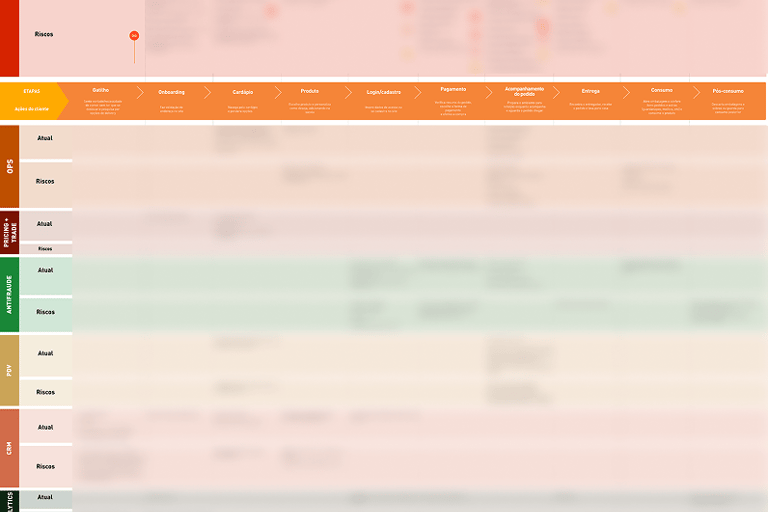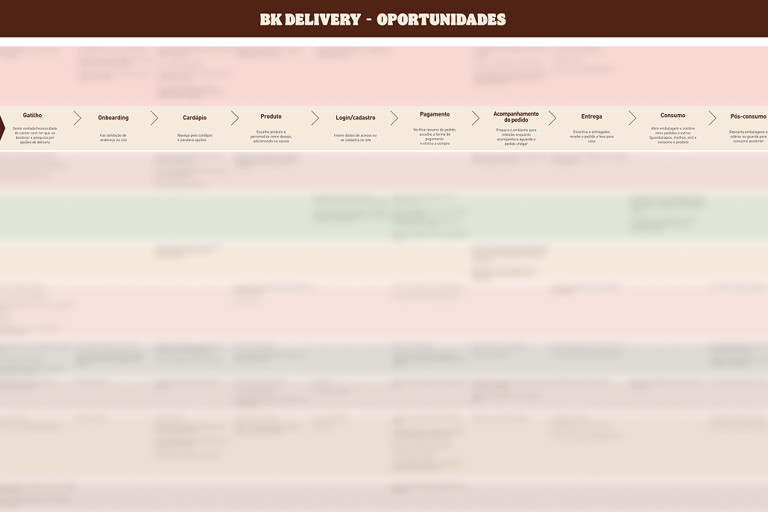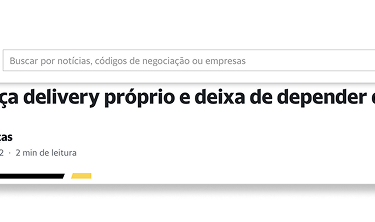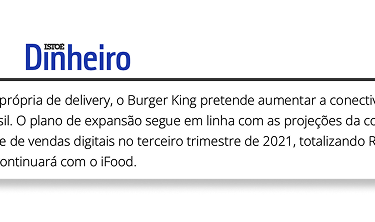Turning challenges into R$231 million in profit
The challenge
With the start of the pandemic and the need for social distancing, Burger King had to quickly create its own delivery service. After a year of operation, it became clear that it was time to review the user experience and design a strategy capable of outperforming competing delivery platforms.
My role
I led the entire UX Research process, focusing on mapping opportunities to improve the journey for customers and stakeholders, working closely with the Product team to plan and prioritize the strategic roadmap.
Main steps:
Stakeholder interviews
Analysis of previous research
Analysis of customer complaints
Website evaluation
Strategy design
Redesign of the website flow
Creation of the blueprint
Business goals
Implement delivery in areas not yet covered by other platforms
Increase the profitability of the in-house operation
Reduce the number of customer complaints about delays and undelivered orders
Research goals
Understand how each stakeholder impacts the delivery flow
Identify what motivates delivery drivers and the main causes of customer complaints
UX goals
Identify possible issues on the website and app
Define a more efficient and intuitive navigation flow
Create a roadmap of prioritized improvements
A little over a year after launching its own delivery service, Burger King was facing a challenging scenario: sales targets were far from being met, and customer complaints about delays and undelivered orders were frequent. On top of that, there was a strategic goal to expand coverage into new regions and reduce dependence on (and the costs of) third-party platforms. This presented a clear opportunity to increase profit margins and strengthen the brand.
Process
12
Interviews
17
involved areas
3
months
The invitation to transformation
I was invited to lead the restructuring of the delivery experience, with a clear mission: to identify the critical points in the operation, engage all the involved areas, and propose solutions that would truly make a difference for both the customer and the business.
Immersion and diagnosis
My first step was to dive into previous studies and analyze all available materials, including two qualitative surveys already conducted with restaurant teams and delivery drivers. At the same time, I held meetings with the delivery team to understand the real context and the daily challenges.
I quickly realized that, despite the large amount of information, there was a lack of an integrated view of the process. So, I decided to build a map based on in-depth interviews with stakeholders from different areas. The goal was to understand how each department impacted the customer journey, what the main risks were, and where the opportunities for improvement could be found.
The research
I conducted 12 in-depth interviews, each lasting about an hour. The interview guide was designed to map the activities of each department and, most importantly, to reconstruct the customer journey from start to finish, identifying all touchpoints, problems, and opportunities.
At the same time, I maintained a weekly routine of analyzing customer reviews, sales data, and website analytics. This combination of methods allowed me to validate qualitative insights with quantitative data, providing a 360º view of the problem.
Journey mapping
With all the information gathered, I cross-referenced the data and created two journey maps:
Current Journey: At the top, it showed how the delivery department operated at each stage. At the bottom, it detailed the role and risks of each area of the company.
Journey with Opportunities: Using the same structure, but now including improvement suggestions for delivery and showing how other departments could get involved to maximize results.




Turning Insights into Business Strategy
The outcome of this work exceeded the expectations of a traditional research project: we delivered a systemic and integrated view of the challenges, engaged stakeholders from multiple areas around common strategic goals, and created an actionable roadmap with measurable KPIs and direct impact. Burger King started to see delivery not just as a sales channel, but as a strategic experience for the brand’s sustainable growth.




Technical Insights and Strategic Opportunities Identified by Area
Operation
Context: This is the central area that manages and receives problems from all other departments, but doesn’t always have the autonomy to solve them directly.
Contribution: Essential for the detailed mapping of the user journey, which didn’t exist until then.
Impact: Creation of the first integrated service blueprint, connecting all touchpoints and responsibilities.
Pricing & Trade
Opportunity identified: Implementation of big data analytics for competitive price monitoring on aggregators and offer personalization.
Proposed solution: Dynamic pricing system with recommendation algorithms based on order history and user behavior.
Expected impact: Increased contribution margin and average ticket through intelligent upselling.
Anti-fraud
Critical context: This area is under constant pressure, lacking adequate security systems due to conflicts with other platforms, and is a target for cloned card tests and “order not received” fraud.
Strategic solution: Implementation of tracking and machine learning systems to detect fraudulent patterns, plus delivery confirmation through data triangulation between courier and customer.
Impact: Significant reduction in chargebacks and increased operational reliability.
POS (Point Of Sale)
Pain point identified: Manual inventory management leading to orders for unavailable products and lack of prioritization between channels (counter, own delivery, and third-party delivery).
Technical solution: Integrated inventory management system with real-time synchronization and order prioritization algorithm based on SLA and restaurant demand.
Result: Elimination of canceled orders due to out-of-stock products and optimized preparation time.
CRM
Gap identified: System not integrated with delivery, requiring manual data entry and making it impossible to target promotional products.
Opportunity: Integration of a customer data platform (CDP) with campaign automation and offer personalization.
Impact: Improved customer experience and increased marketing campaign effectiveness.
Analytics
Context: Outsourced SEO with no updates and lack of insights on product performance.
Proposed improvement: Implementation of advanced analytics with heatmaps of most/least ordered products and menu personalization based on machine learning.
Result: Optimized product discovery and increased conversion.
Critical issue: No delivery option in the app, separate registrations, and no real-time support for complaints.
Solution: Single sign-on (SSO), full delivery integration in the app, and chatbot implementation with escalation to human support.
Impact: Unified user experience, with single login and delivery inside the app.
Loyalty
Strategic gap: Loyalty program not integrated with delivery, preventing point accumulation and usage.
Opportunity: Full integration of the loyalty program with gamification and specific rewards for delivery.
Result: Increased customer retention and lifetime value.
Media
Challenge: Campaigns targeting customers outside the delivery coverage area.
Solution: Smart geo-targeting with segmentation by delivery area and campaign personalization.
Impact: Optimized ROAS (Return on Ad Spend) and reduced customer frustration.
Measurable Business Impact
The proprietary delivery service was relaunched, already incorporating the main changes suggested by the research. Throughout the year, new updates and integrations with other brand products were implemented, consolidating a more efficient and innovative operation. This ongoing evolution process ensured Burger King a unique and competitive delivery experience, with a direct impact on profits, which reached a record R$231.4 million in digital sales in a single quarter.
Turning Insights into Business Strategy
The outcome of this work exceeded the expectations of a traditional research project: we delivered a systemic and integrated view of the challenges, engaged stakeholders from multiple areas around common strategic goals, and created an actionable roadmap with measurable KPIs and direct impact. Burger King started to see delivery not just as a sales channel, but as a strategic experience for the brand’s sustainable growth.




Technical Insights and Strategic Opportunities Identified by Area
Operation
Context: This is the central area that manages and receives problems from all other departments, but doesn’t always have the autonomy to solve them directly.
Contribution: Essential for the detailed mapping of the user journey, which didn’t exist until then.
Impact: Creation of the first integrated service blueprint, connecting all touchpoints and responsibilities.
Pricing & Trade
Opportunity identified: Implementation of big data analytics for competitive price monitoring on aggregators and offer personalization.
Proposed solution: Dynamic pricing system with recommendation algorithms based on order history and user behavior.
Expected impact: Increased contribution margin and average ticket through intelligent upselling.
Anti-fraud
Critical context: This area is under constant pressure, lacking adequate security systems due to conflicts with other platforms, and is a target for cloned card tests and “order not received” fraud.
Strategic solution: Implementation of tracking and machine learning systems to detect fraudulent patterns, plus delivery confirmation through data triangulation between courier and customer.
Impact: Significant reduction in chargebacks and increased operational reliability.
POS (Point Of Sale)
Pain point identified: Manual inventory management leading to orders for unavailable products and lack of prioritization between channels (counter, own delivery, and third-party delivery).
Technical solution: Integrated inventory management system with real-time synchronization and order prioritization algorithm based on SLA and restaurant demand.
Result: Elimination of canceled orders due to out-of-stock products and optimized preparation time.
CRM
Gap identified: System not integrated with delivery, requiring manual data entry and making it impossible to target promotional products.
Opportunity: Integration of a customer data platform (CDP) with campaign automation and offer personalization.
Impact: Improved customer experience and increased marketing campaign effectiveness.
Analytics
Context: Outsourced SEO with no updates and lack of insights on product performance.
Proposed improvement: Implementation of advanced analytics with heatmaps of most/least ordered products and menu personalization based on machine learning.
Result: Optimized product discovery and increased conversion.
Critical issue: No delivery option in the app, separate registrations, and no real-time support for complaints.
Solution: Single sign-on (SSO), full delivery integration in the app, and chatbot implementation with escalation to human support.
Impact: Unified user experience, with single login and delivery inside the app.
Loyalty
Strategic gap: Loyalty program not integrated with delivery, preventing point accumulation and usage.
Opportunity: Full integration of the loyalty program with gamification and specific rewards for delivery.
Result: Increased customer retention and lifetime value.
Media
Challenge: Campaigns targeting customers outside the delivery coverage area.
Solution: Smart geo-targeting with segmentation by delivery area and campaign personalization.
Impact: Optimized ROAS (Return on Ad Spend) and reduced customer frustration.
Measurable Business Impact
The proprietary delivery service was relaunched, already incorporating the main changes suggested by the research. Throughout the year, new updates and integrations with other brand products were implemented, consolidating a more efficient and innovative operation. This ongoing evolution process ensured Burger King a unique and competitive delivery experience, with a direct impact on profits, which reached a record R$231.4 million in digital sales in a single quarter.
